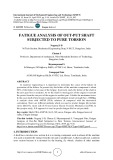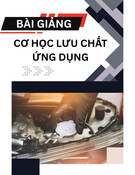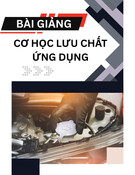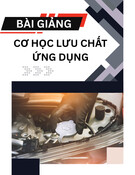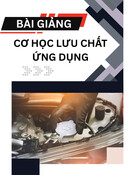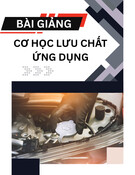
http://www.iaeme.com/IJMET/index.asp 9 editor@iaeme.com
International Journal of Mechanical Engineering and Technology (IJMET)
Volume 10, Issue 04, April 2019, pp. 9-16, Article ID: IJMET_10_04_002
Available online at http://www.iaeme.com/ijmet/issues.asp?JType=IJMET&VType=10&IType=4
ISSN Print: 0976-6340 and ISSN Online: 0976-6359
© IAEME Publication Scopus Indexed
FATIGUE ANALYSIS OF OUT-PUT SHAFT
SUBJECTED TO PURE TORSION
Nagaraj S B
M Tech Student, Mechanical Engineering Dept, N.M.I.T, Bengaluru, India
Chetan S
Professor, Department of mechanical, Nitte Meenakshi Institute of Technology,
Bangalore, India
Shyamaprasad S
Sr.Manager, Off-highway R&D) AVTEC Ltd, Hosur, Tamilnadu, India
Venugopal Nair
AGM (Off-highway R&D) AVTEC Ltd, Hosur, Tamilnadu, India
ABSTRACT
In material engineering it is important to determine the cause of the failure &
prevention of the failure .In present day the failure of the machine component is about
90% of the failure is because of the fatigue. In present study the failure of the shaft in
the yaw gear box is analyzed .As we the shaft is rotating part of the engine it transmit
the power from the one part of the engine to another part. It holds the maximum stress.
In this case shaft of heat treated component with ultimate tensile strength Su= 2100Mpa
is analysis done with ANSYS (FEA) software & compared with the theoretical
calculation. There are different methods which are used to predict fatigue life include
stress life(S-N), strain Life (E-N) and Linear Elastic Fracture Mechanics (LEFM). In
this project study, S-N approach is used to predict fatigue life for out-put shaft.
Key words: Shaft, FEA-ANSYS (16.2), SN-curve, Fatigue –life, Fatigue factor of
safety, Fatigue damage
Cite this Article: Nagaraj S B, Chetan S, Shyamaprasad S, Venugopal Nair, Fatigue
Analysis of Out-Put Shaft Subjected to Pure Torsion, International Journal of
Mechanical Engineering and Technology 10(4), 2019, pp. 9-16.
http://www.iaeme.com/IJMET/issues.asp?JType=IJMET&VType=10&IType=4
1. INTRODUCTION
A shaft has a circular cross section & it is a rotating component used in almost all the machine
.It is used to transfer the energy from the one part to another part .A shaft usually not a uniform
cross section because it is mounted by the bearing, fly wheels, clutches & other machine





